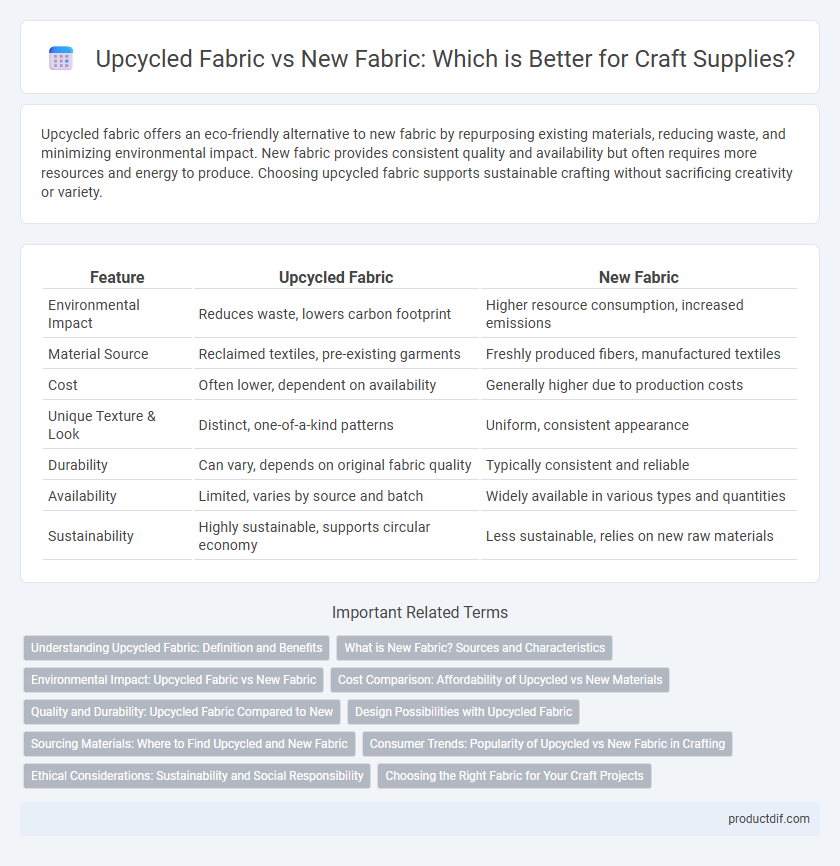Upcycled fabric offers an eco-friendly alternative to new fabric by repurposing existing materials, reducing waste, and minimizing environmental impact. New fabric provides consistent quality and availability but often requires more resources and energy to produce. Choosing upcycled fabric supports sustainable crafting without sacrificing creativity or variety.
Table of Comparison
| Feature | Upcycled Fabric | New Fabric |
|---|---|---|
| Environmental Impact | Reduces waste, lowers carbon footprint | Higher resource consumption, increased emissions |
| Material Source | Reclaimed textiles, pre-existing garments | Freshly produced fibers, manufactured textiles |
| Cost | Often lower, dependent on availability | Generally higher due to production costs |
| Unique Texture & Look | Distinct, one-of-a-kind patterns | Uniform, consistent appearance |
| Durability | Can vary, depends on original fabric quality | Typically consistent and reliable |
| Availability | Limited, varies by source and batch | Widely available in various types and quantities |
| Sustainability | Highly sustainable, supports circular economy | Less sustainable, relies on new raw materials |
Understanding Upcycled Fabric: Definition and Benefits
Upcycled fabric refers to textile materials repurposed from existing garments or scraps, reducing waste and conserving resources. This sustainable choice minimizes environmental impact by diverting fabric from landfills and lowering the demand for virgin textile production. Upcycled fabric offers unique textures and patterns, supporting eco-friendly crafting while inspiring creativity in custom projects.
What is New Fabric? Sources and Characteristics
New fabric originates directly from raw materials such as cotton, wool, silk, or synthetic fibers like polyester and nylon, offering pristine quality and uniform texture. It is produced in textile mills using processes like spinning, weaving, and dyeing to ensure consistent strength, colorfastness, and durability. Sources of new fabric include natural fiber plantations and petrochemical factories, providing a wide range of options for various craft projects requiring fresh, uncontaminated material.
Environmental Impact: Upcycled Fabric vs New Fabric
Upcycled fabric significantly reduces environmental impact by diverting textile waste from landfills and minimizing the demand for water, energy, and chemicals typically involved in producing new fabric. New fabric production contributes to high carbon emissions and extensive resource consumption, including water-intensive processes in cotton cultivation and synthetic fiber manufacturing. Choosing upcycled fabric supports sustainable crafting by lowering pollution and resource depletion compared to traditional new fabric options.
Cost Comparison: Affordability of Upcycled vs New Materials
Upcycled fabric offers a significantly more affordable option compared to new fabric, often costing up to 50-70% less due to its use of reclaimed materials. New fabrics involve higher production costs driven by raw materials, manufacturing, and transportation expenses. Choosing upcycled materials not only reduces environmental impact but also provides budget-conscious crafters access to unique textures and patterns without the premium price tag of brand-new textiles.
Quality and Durability: Upcycled Fabric Compared to New
Upcycled fabric often exhibits unique textures and character due to its previous use, but new fabric generally offers more consistent quality and durability, making it ideal for long-lasting craft projects. While upcycled materials can have varying wear and strength depending on their prior condition, new fabrics provide reliable performance with standardized manufacturing processes. Choosing between upcycled and new fabric involves balancing sustainability and ecological benefits against the demand for uniform quality and durability in crafting supplies.
Design Possibilities with Upcycled Fabric
Upcycled fabric offers unique design possibilities by incorporating diverse textures, patterns, and colors from repurposed materials, making each piece distinctly original. Unlike new fabric, upcycled materials encourage innovative patchwork and mixed-media techniques that enhance creativity and sustainability in craft projects. Designers can leverage the inherent character and history of upcycled fabrics to produce one-of-a-kind items that appeal to eco-conscious consumers.
Sourcing Materials: Where to Find Upcycled and New Fabric
Sourcing upcycled fabric often involves exploring thrift stores, textile recycling centers, and online marketplaces specializing in pre-loved materials. New fabrics are commonly found at fabric stores, wholesale suppliers, and dedicated textile manufacturers offering a wide range of fibers and patterns. Craft enthusiasts prioritize sustainability when choosing upcycled fabrics for eco-friendly projects and design versatility with new fabrics for consistent quality.
Consumer Trends: Popularity of Upcycled vs New Fabric in Crafting
Upcycled fabric has gained significant traction among eco-conscious crafters, reflecting a growing consumer trend toward sustainable and ethical crafting materials. While new fabric maintains popularity due to its vast color and texture options, the demand for upcycled textiles is driven by increasing awareness of environmental impact and the desire for unique, one-of-a-kind projects. Market data indicates a steady rise in the percentage of crafters opting for upcycled fabrics in DIY projects, underscoring a shift in purchasing behavior toward sustainability in the craft supply industry.
Ethical Considerations: Sustainability and Social Responsibility
Upcycled fabric significantly reduces environmental impact by minimizing textile waste and conserving resources compared to new fabric production, which often involves intensive water usage and chemical treatments. Ethically, upcycled materials support circular economy principles, promoting social responsibility through less exploitative labor practices and reduced carbon footprints. Choosing upcycled fabric advances sustainability goals, aligning with eco-friendly craft supplies that prioritize both ethical sourcing and waste reduction.
Choosing the Right Fabric for Your Craft Projects
Upcycled fabric offers eco-friendly benefits by repurposing existing materials, reducing waste, and often providing unique textures and patterns ideal for sustainable craft projects. New fabric delivers consistency in quality, vibrant colors, and a wide variety of materials like cotton, silk, or polyester, allowing for greater control over durability and appearance. Selecting the right fabric depends on your project's goals, whether prioritizing environmental impact with upcycled options or seeking specific textile properties from newly manufactured materials.
Upcycled fabric vs New fabric Infographic

 productdif.com
productdif.com